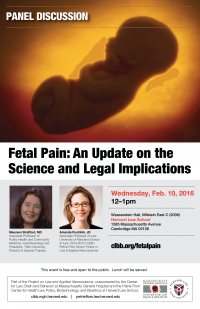By Robert Kinscherff, Senior Fellow in Law & Applied Neuroscience
I recently attended a presentation on Fetal Pain: An Update on the Science and Legal Implications, jointly sponsored by the Center for Law, Brain and Behavior (Massachusetts General Hospital) and the Petrie-Flom Center (Harvard Law School). Presenters were Amanda Pustilnik, JD (University of Maryland School of Law) and Maureen Strafford, MD (Tufts University School of Medicine). Video of the event is available on the website, and I encourage everyone to watch the full discussion for themselves.
Doctor Strafford delivered a masterful overview of the trajectory of scientific perspective and research about children and pain. Over the course of her career, the medical perspective has transformed from “children do not feel pain” to “children do not remember pain” to inquiry into “when and how children feel pain.” Strafford described the medical complexities of understanding the physical and subjective aspects of pain as well as the impossibility of confidently “pinpointing” the exact point in fetal development when a neonate experiences pain.
Professor Pustilnik gave an equally compelling review of law and legal language regarding abortion, particularly law that specifically references fetal pain as a reason for limiting abortion. This served to frame a conversation about pain and suffering in the law and the ways in which law reflects normative considerations and provides rhetoric (viewed respectively by partisans as “compelling” or “inflammatory”) to political discourse. In this case, discourse about fetal pain both attracts attention and is intended to facilitate empathy for the neonate.
Taken together, Pustilnik and Strafford made a powerful case that the current discourse about fetal pain reflects a strategic communication strategy intended to advance the cause of abortion opponents. Continue reading »




